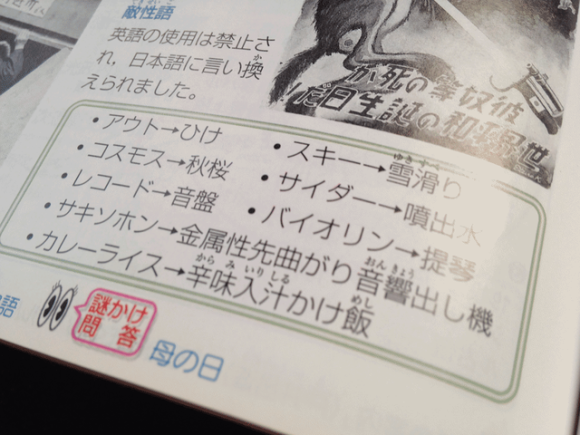
A photo of what appears to be an entry in a Japanese textbook tweeted by Kurita as been surprising netizens across the country. It shows a list of foreign loan words that had been turned into Japanese during the early 1940s. Most surprising of the list, as pointed out by netizens, was the word for “saxophone,” which was transformed into an awkward 19-character-long mouthful. Let’s take a closer look at why this happened and the results of English being deemed an “enemy language” during WWII.
As a result of ultra-nationalistic sentiment during WWII, English was designated as a tekiseigo, or “enemy language” and its use was discouraged in the public sphere during the early 1940s. Although official laws regarding tekiseigo were never issued by the Japanese government, many officials urged that words utilizing romanized letters or even katakana, the Japanese syllabary for foreign loan words, be eliminated.
▼ An article from Japanese magazine, Shashin Shūhō, urging all citizens to stop using English (February 3, 1943)
As a result, many companies and organizations voluntarily decided to change their name. The Japanese wikipedia entry for tekiseigo cites several dozen examples of companies changing their names during this time, such as King Record (キングレコード) becoming Fuji Onban (富士音盤).
As the use of foreign words was quite popular during the early 20th century, the switch from English and katakana to kanji characters was not entirely easy, as proven by many cumbersome creations such as the 19-syllable-long word for saxophone, “金属性先曲がり音響出し機.” Even baseball, a sport loved by the entire nation at the time, abandoned the original call of “strike,” replacing it with “よし一本,” meaning “all right, one.” Sliding into home would be met, not with a call of “safe,” but “安全,” the Japanese word for “safety.”
For those with a background studying Japanese, here’s a short list of Japanese words that were created to replace English:
Now in the 21st century, the use of English and other foreign words is prolific in the public and private sector. Many citizens are even able to identify obscure English words such as “context” and “buffer.” Still, even to this day there are some who feel overwhelmed by the amount of non-Japanese words in everyday life. It’s hard to measure the effects this language ban had on the Japanese nation during the 1940s, but Japan’s modern day relationship with English speaks volumes for how much the country has changed.
Source: Hachima Kikou, Weblio.jp
Image: Wikipedia